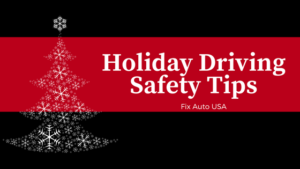Holiday Driving: Tips To Travel Safe During the Holidays
November 6th, 2020 by Nikki Guerra

This year’s holiday season will be different due to the coronavirus (COVID-19) pandemic. If you plan to travel to a holiday celebration with family and friends, you should prepare accordingly.
Travel restrictions are in place in cities and towns nationwide. As such, make sure to comply with local mandates and U.S. Centers for Disease Control and Prevention (CDC) guidelines to ensure that you and your loved ones can safely celebrate the holidays.
Along with complying with local travel regulations, you should practice safe driving throughout the holiday season. With this list of holiday travel tips for driving at your disposal, you can safely navigate the roads and avoid an accident that would otherwise put your holiday celebration in jeopardy.
Safe Driving Tips for the Holiday Season
The holidays are the time of year when families gather from near and far, which means there are more cars on the highways than usual. According to the Bureau of Transportation Statistics, the number of long-distance trips (50+ miles one way) increases by 23% around Christmas and New Year’s Day. Throw in high winter winds, rain, snow, and ice, and it can lead to unsafe driving conditions in many parts of the country.
Practicing the following driving tips, especially during the holidays, can help you safely arrive at your final destination.
1. Get your car ready for the trip.
Start with some basic auto maintenance and safety checks. Check your tire pressure and tread depth to ensure they meet recommended safety levels. If you expect to be driving on snow or ice, change to snow tires or all-weather tires with snow studs.
Check the battery to make sure it has sufficient “juice.” The last thing you want is to get stranded by the side of the road in sub-freezing weather with an engine that won’t start. Check the level of antifreeze in your radiator and fill the windshield wiper washer’s reservoir. If necessary, replace worn out wiper blades.
2. Prepare an emergency roadside kit.
If you do get stranded, a winter emergency kit can be a literal lifesaver. Essentials include first aid supplies, jumper cables, an ice scraper, and a snow brush. Other items you’ll want to have include:
- Extra gloves, hats, and blankets
- Flashlights with fresh batteries
- Warning flares or reflective triangles
- Drinking water and nonperishable snacks
- Warm clothes
- Basic hand tools and a shovel
- Cell phone chargers
3. Plan your route.
Map out the best way to reach your destination, and identify an alternative in case of road closures due to severe weather. Before leaving, check your smartphone app to identify any heavy traffic areas and how to avoid them.
4. Check weather and road conditions before you leave.
This is especially important if your route will take you through mountain passes or other areas with potentially unsafe roads. Consult a weather app on your smartphone to stay up to date on current conditions.
5. Keep children safe.
Use baby and booster seats for children of appropriate ages. Make sure you know how to properly secure them.
6. Take frequent rest breaks.
In pre- and post-pandemic times, insurance carrier and auto safety expert AAA recommends stopping every two hours or 100 miles – whichever comes first – to rest. If you have more than one adult in the car, change drivers at each break to avoid getting over-tired. But during the COVID-19 pandemic, if you stop at a rest area or other populated areas, make sure to wear masks and follow proper COVID-19 safety precautions.
Remember to secure your valuables throughout the trip. Leaving wrapped presents in plain sight inside your car presents a tempting target for thieves, so keep all valuables in the trunk or a covered storage area. If you stay overnight at a roadside hotel, bring them inside your room.
7. Follow CDC travel guidelines.
The CDC offers travel guidelines for those who intend to travel during the pandemic. You should stay up to date on these guidelines to ensure you can safely celebrate the holidays with family and friends.
The CDC recommends that you:
- Wear a face mask. Wear a face mask to help slow the spread of the coronavirus and minimize the risk of infection. The mask should cover the nose and mouth and should be worn whenever you enter a public setting.
- Frequently wash your hands with soap and water. Wash the hands with soap and water as often as possible during your trip. You should wash your hands in soap and water for a minimum of 20 seconds every time. If you’re unable to wash your hands, you can use hand sanitizer that contains at least 60% alcohol to keep your hands clean, as well.
- Watch for signs of a coronavirus infection. Keep an eye out for fever, difficulty breathing, or any other signs of a COVID-19 infection. If you believe you or someone traveling with you may be dealing with a COVID-19 infection, get tested immediately.
- Receive proper testing. If travel requirements stipulate that you must get tested to enter a particular state, undergo a coronavirus assessment. Don’t travel until it has been confirmed that you have tested negative for a COVID-19 infection. If you are dealing with a coronavirus infection, quarantine for at least 14 days.
- Practice social distancing. Maintain a physical distance of at least 6 feet from anyone outside of your immediate household. If you have been in close contact with a family member or friend who tests positive for COVID-19, you should get tested for the coronavirus and quarantine accordingly.
- Avoid frequent stops during your trip. Whenever possible, limit the number of stops during your trip. If you need to get a hotel during your trip, contact the hotel in advance and follow its guidelines to check-in and check-out safely. You can also pack food and drinks, so you can forgo stops at restaurants and convenience stores throughout your trip.
- Use disinfectant wipes when you fuel up. Whenever you visit a gas station to refuel your car, apply a disinfectant wipe on the gas pump buttons and handle. Many gas stations have disinfectant wipes available, or you can carry them in your vehicle. If a gas station doesn’t offer disinfectant wipes, clean your hands with soap and water immediately after refueling your car.
Use Safe Winter Driving Techniques
Now that you know what to do before embarking on your trip, here’s what to do if you’re driving in inclement weather:
- Accelerate and decelerate slowly.
- Don’t follow other vehicles too closely. Leave plenty of space between you and the car in front of you.
- Drive slowly and allow extra time for braking and coming to a stop.
- Don’t stop when going up a hill; reduce speed when going down.
- Avoid using cruise control when driving on snowy or icy roads.
- Know how to respond if your car skids on snowy or icy roads.
- Keep your windshield clear at all times.
- Keep your lights on during the day.
If you experience engine problems or road conditions become too severe to continue driving, pull over in a safe place and stay with your vehicle. This will provide shelter while making it easier for rescuers to locate you. Attaching a colorful piece of cloth to your antenna or car racks can also help search parties find you.
If you run the engine to keep warm, make sure that snow, ice, or mud isn’t clogging your exhaust pipe. Otherwise, carbon monoxide gas could leak into your car and cause sickness or worse.
If you are involved in a car collision, don’t let the incident ruin your holiday celebration. Ensure you and any others involved in the accident are safe and report the incident to the police. You can also take your car to a certified auto body professionals at Fix Auto to quickly and effectively address any dents, dings, and other exterior damage to your vehicle. To schedule a service appointment, please contact us online or call us today at 800.INFO.FIX.
This blog post was contributed by Fix Auto Palmdale, a leading industry expert and collision repair shop servicing Palmdale.
Welcome to
Fix Auto USA
We are the premier independent body shop network delivering world-class customer service and high-quality collision repairs across the U.S.
Learn About Us





